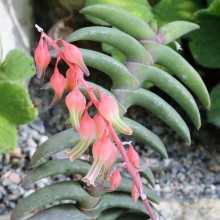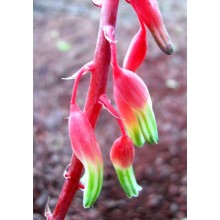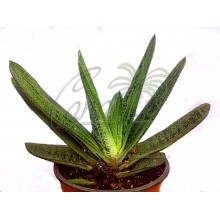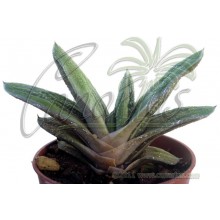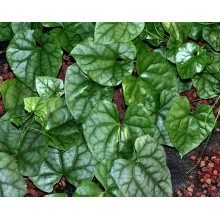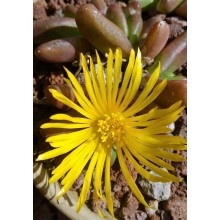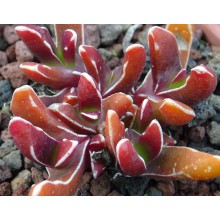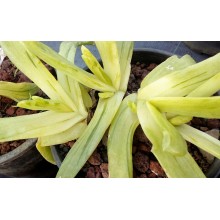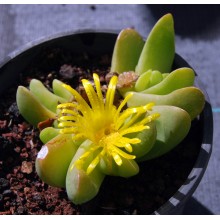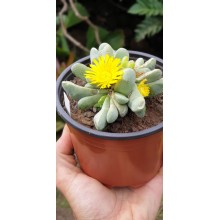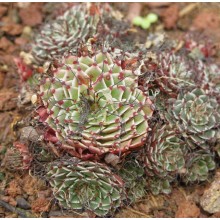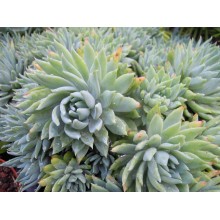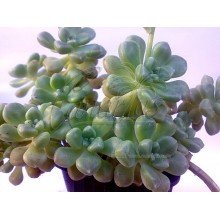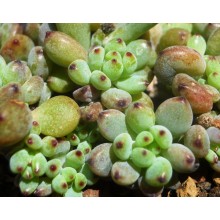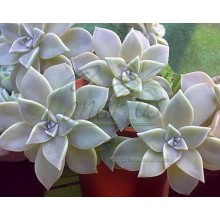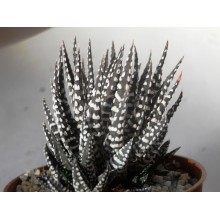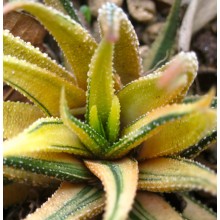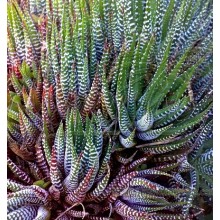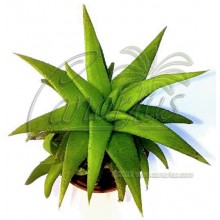Succulente Ci sono 628 prodotti.

I deserti del mondo e le zone secche ospitano le piante più interessanti. Canarius offre una selezione crescente di piante succulente di massima qualità, perché sono coltivate all'aperto, in pieno sole delle Isole Canarie.
I succulente o "piante grasse" sono specie di ritenzione di acqua, adattate alle condizioni di asciutto. Loro accumulano succum (succo, acqua) nelle loro foglie, steli o radici, e spesso mostrano un aspetto robusto e carnoso.
Sotto-categorie
-
Agave
Agave è un genere di piante grasse provenienti dall'America. Alcune specie crescono in zone fredde e possono sopportare un forte gelo, mentre altri vivono in climi tropicali. Alcuni sono piccoli nani e alcuni sono giganti, fino a 2 o 3 m di larghezza.
Le agavi resistenti al freddo possono creare un effetto esotico nel vostro giardino. Le specie agave fanno bella compagna di palme o cactus. Le agavi variegate sono incredibilmente ricercati dai collezionisti. Il nostro negozio web offre una selezione in continua evoluzione delle specie. Spediamo piante a radice nuda, se non diversamente specificato.
-
Aloe, Gasteria & Haworthia
Aloe, Gasteria e Haworthia sono tre generi correlate, comprese centinaia di piante succulente. Sono tutti facilmente coltivate in vaso. Alcuni si adattano a bassi livelli di luce di condizioni interne e possono essere coltivate come piante da appartamento.
- Aloe è un genere di circa 400 specie, originarie di Africa, Arabia e Madagascar. I aloe piccoli o nani stanno diventando particolarmente popolare in climi più freddi in quanto possono essere presi in casa durante i mesi più duri.
- Gasteria comprende circa 80 specie endemiche in Sud Africa, conosciuti per le loro foglie spettacolari che sono lucide, screziati e ruvidi. Fioriscono in primavera-estate con lunghe punte di piccoli fiori arancioni. Alcune specie sono talmente variabile che offriamo cloni particolari di località specifiche.
- Haworthia è un genere endemico in Sud Africa con circa 70 specie e un certo numero di sottospecie locali, varietà e forme. Le foglie sono spesso banded, punteggiati, punteggiato, o semi-trasparente e mostrano ampie variazioni.
-
Crassule
Questa è una nuova e crescente sezione di specie della famiglia Crassulaceae. Ci sono circa 1.400 specie in 33 generi et la loro distribuzione è in tutto il mondo, ma si presentano più nell'emisfero Nord e Sud Africa, in particolare in ambienti asciutti. Qui si possono acquistare piante sani, indurito dal sole, coltivati nelle isole Canarie e spediti a casa tua.
-
Mesembriantemi
Questo gruppo di piante del deserto è chiamato Mesembriantemi perché appartengono a una famiglia botanica precedentemente denominata Mesembryanthemaceae. Ci sono quasi 2.000 specie, che si trovano principalmente in Africa del sud, con adattamenti estremi agli habitat secco. Alcuni sono chiamati "pietre vive", perché sembrano come ciottoli. Molti sono facili da coltivare e il loro bisogno principale è pieno sole. Alcuni sono difficili perché crescono nelle aree veramente estreme.
Il nostro Web Shop offriamo piante sane coltivate al sole, con foglie compatte e colorate. Alcune piante sono venduti come talee, e altri come piante radicate, di almeno due anni. -
Sansevieria
Recentemente assegnato alla famiglia Asparagaceae, il genere Sansevieria conta circa 70 specie, quasi tutti nativi in Africa, Arabia e Madagascar. Erbe perenni adatti per gli habitat secchi con foglie rigide, succulente, la loro lunghezza varia da pochi centimetri a 2 metri. Sansevieria trifasciata e le sue numerose cultivar sono tra le piante d'appartamento più apprezzati, popolarmente chiamata la lingua di suocera. Una pianta ben coltivata di solito produce un picco di molti fiori bianchi, riccamente profumati e poi bacche arancioni. Anche le specie più rare sono resistenti ad abbandono, a condizione di tenerli dal gelo in inverno e sole cocente in estate.
-
Hoya
Le Hoyas sono rampicanti, dai fiori esotici e spesso vistosi. Provengono dalle foreste pluviali in Asia e Oceania. La maggior parte delle specie vive bene a mezz' ombra e si adatanno a vivere in casa come piante da appartamento. Sono ideali per cesti e tralicci. Tollerano un paio di settimane di siccità, ma sono sensibili al gelo e freddo. Molte hoya i sono facili da far crescere e fiorire, mentre alcune sono difficili e rare.
-
Asclepiadaceae
Le Asclepiade, o Asclepiadoideae, sono una sottofamiglia delle Apocynaceae, che annoverano circa 2900 specie diverse. Tra queste si trovano molti fusti privi di foglie ma anche erbe perenni, arbsuti, liane e, raramente, alberi. Producono fiori molto belli, dato il complesso sistema di impollinazione. Molte specie producono un odore insolito, spesso associato a quello di una carogna, la cui funzione è quella di attrarre le mosche che poi andranno a impollinare i fiori. -
Caudiciformi
Queste piante, dette anche pachicauli, sono tipiche delle zone aride. Producono un tronco insolitamente grosso e sproporzionato, detto caudice (a volte anche tubero), spesso con ramificazioni. Il caudice può essere anche nascosto sottoterra, ma nella maggior parte dei casi ha sviluppo verso l'alto, dando luogo ad alberi dalla forma spettacolare. I caudiciformi più grandi sono i baobab. -
Altre succulente
Qui troverete tutte quelle specie di piante del deserto che non sono inclusi nella propria categoria. Metteremo qui tutte le piante provenienti da famiglie inusuali, diversi da Agavi, Aloe, Crassulaceae, Sansevieria, Mesembriantemi, Epiphytic cacti, etc.
-
Gasteria sp. Schweinfurthii
Gasteria sp. Schweinfurthii
This is a quite obscure species, because the name shweinfurthii was never described officialy. Nevertheless it is a spectacular plant with bold leaves and showy flower spikes.
10,20 € -
Gasteria x Little Warty
Gasteria x Little Warty
NEW !- Rooted plant, 6-8 cm. Ornamental, hybrid Gasteria. Robust plant with dark green leaves, coated with jade green tubercules and showy pale margins.
10,50 € -
Gasteria x Silberstreif
Gasteria x Silberstreif
Cont.= 6 cm. Little known hybrid of German origin. Grey-green tubercles and margins contrast on a darker background.
10,30 € -
Glottiphyllum pygmaeum
Glottiphyllum pygmaeum
This is the most compact species in the genus Glottyphyllum, and to many the most beautiful. Bake it in full sun and it will turn deep red when stressed.
11,70 € -
Glottiphyllum difforme
Glottiphyllum difforme
This is the most beautiful and least known species in the genus Glottiphyllum. Few collectors grow it and no pictures in the web show the beauty of well-grown plants.
16,80 € -
Glottiphyllum neilii
Glottiphyllum neilii
The "King of the Glotts" is said to be the largest of all the species in the genus Glottiphyllum. Leaves can get quite red when somehow stressed, It is easy to grow, and just as the rest of the genus Glottiphyllum it is chiefly winter-growing but it does not have a true resting season.
10,70 € -
Glottiphyllum oligocarpum
Glottiphyllum oligocarpum
This is a very attractive compact and blue glotty. Leaves are short and waxy and can look blue to grey. The flowers are so large that they cover the whole rosette.
12,00 € -
Graptopetalum filiferum
Graptopetalum filiferum
Rooted rosette. This graptopetalum with jade-green leaves is so compact that it resembles a Sempervivum. It is native to Chihuahua , in Mexico and flowers in Winter. It branches very slowly and will eventually fill the pot and form a solid mat.
23,20 € -
Graptopetalum macdougallii
Graptopetalum macdougallii
Large Mature Cutting - Large rosettes of ornamental blue leaves. It grows in cool temperatures and rests in hot weather.
10,70 € -
Graptopetalum mendozae
Graptopetalum mendozae
NEW ! - Three unrooted heads of 3-4 cm. Small succulent with thick, pearl-coloured leaves and white flowers. It is suitable for hanging pots. Native to Mexico, Veracruz, in the area of Tepetzintla, at 100-150 m.
10,50 € -
Graptopetalum pachyphyllum
Graptopetalum pachyphyllum
Small ground-covering Graptopetalum with compact rosettes of colourful leaves that can become green, blue or pink according to the season or sun exposure. Flowers are also beautiful, white-green banded in dark red. It is known from populations scattered in the mountains of central Mexico
10,40 € -
Graptopetalum paraguayense
Graptopetalum paraguayense
Two unrooted heads 8-10 cm. Popular Mexican species with glossy pointed leaves ranging from pale blue gray to yellow pink. Suitable for pots, hanging baskets and in rock gardens. It can withstand frost to -3 or much more if kept dry.
10,50 € -
Haworthia attenuata 'Big Band'
Haworthia attenuata 'Big Band'
Supreme selection of the popular Haworthia fasciata. Big Band has white, prominent bands of dots. Leaves turn brown to black in high light, showing a beautiful black and white contrast!
10,40 € -
Haworthia attenuata 'Rainbow'
Haworthia attenuata 'Rainbow'
A supreme variegated clone of attenuata-radula, with different colour shades in each rosette.
12,70 € -
Haworthia attenuata f. caespitosa
Haworthia attenuata f. caespitosa
NEW ! - Rooted plant, 6-8 cm. Description will be placed here as soon as possible.
8,40 € -
Haworthia attenuata var. glabrata
Haworthia attenuata var. glabrata
NEW ! - Rooted, 6-8 cm. Sheer-cliff-dwelling haworthia with firm, clumping rosettes. Leaves are light green and warty.
10,70 €
Al momento ci sono pochi prodotti in questa categoria Succulente

























